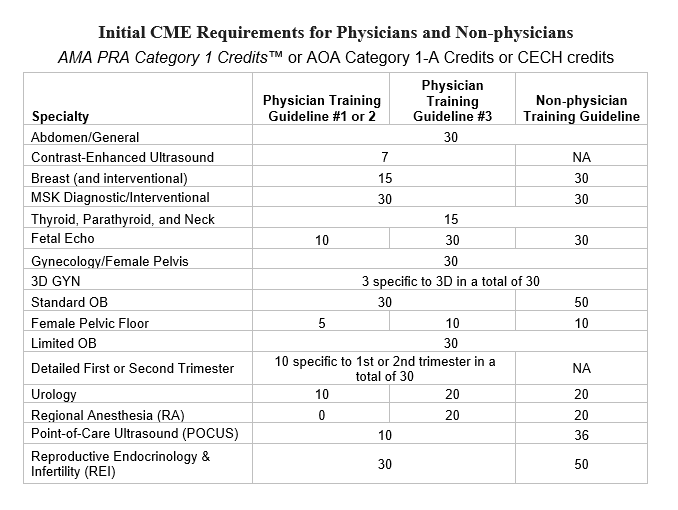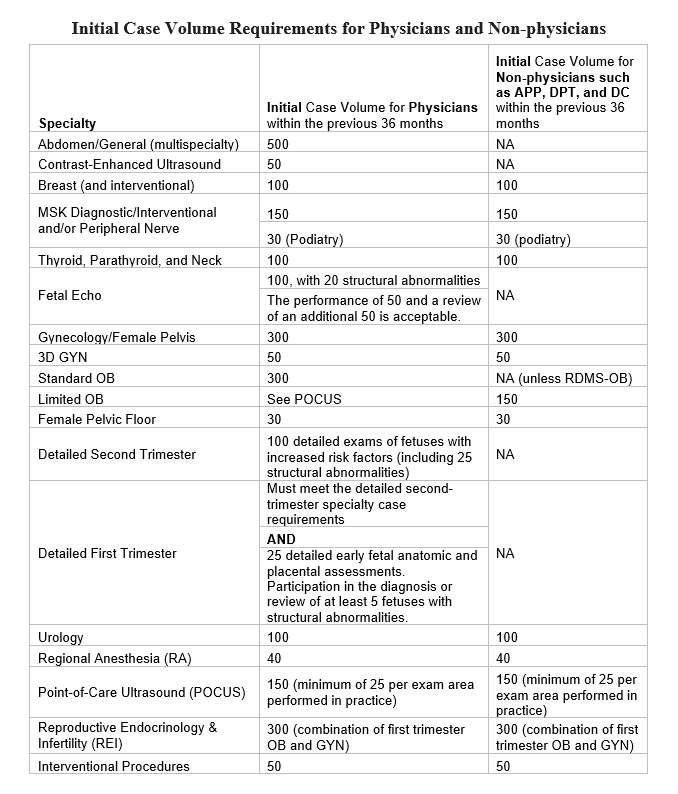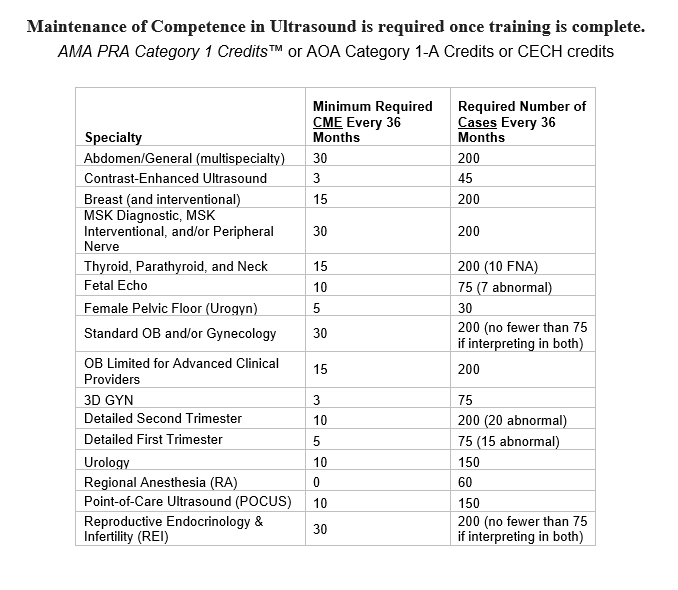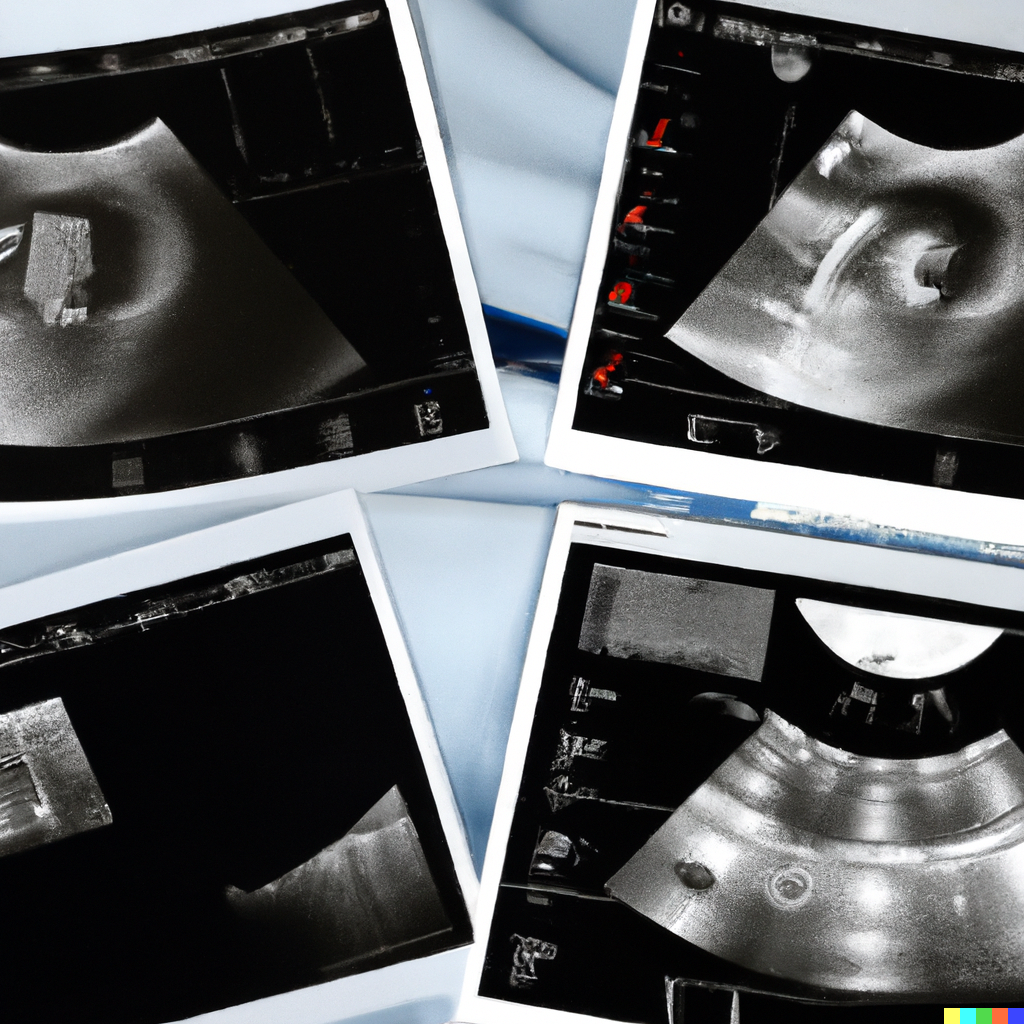Artificial Intelligence in Ultrasound
Artificial intelligence is transforming how medical professionals use ultrasound. Today, artificial intelligence can assist with examination accuracy, diagnoses, measurements, and more. Explore the growing role artificial intelligence plays in patient care.
Education
Training Guidelines
View More »Training Guideline for Licensed Medical Providers Including Advanced Clinical Providers (PAs, NPs, CNMs/CMs), DPTs, and DCs Performing and/or Interpreting Diagnostic Ultrasound Examinations
This competence encompasses but is not limited to:
1. A thorough understanding of indications, limitations, and guidelines of diagnostic ultrasound examinations.
2. Familiarity with alternative and complementary imaging and diagnostic procedures, including the ability to correlate results with ultrasound findings.
3. Knowledge of the basic physical principles of ultrasound, including power output and adherence to the ALARA principle, patient and operator safety, and recommendations for quality assurance of ultrasound equipment.
4. Demonstrate a thorough understanding of the anatomy, physiology, and pathophysiology of those organs being examined, providing the knowledge and experience to differentiate between normal and abnormal findings.
5. Training experience must be based on the ability to analyze a full set of images, which comprises the entire examination to determine completeness and image quality to render a clinically appropriate diagnostic interpretation.
6. The training must include methods of documentation and reporting of ultrasound studies.
Physician Associates/Assistants (PAs), Nurse Practitioners (NPs), Certified Nurse-Midwives/Certified Midwives (CNMs/CMs), Chiropractors (DCs), and Physical Therapists (DPTs) should meet at least one of the following pathways (A–K) AND have met the AIUM case volume experience requirement as outlined in initial training.
During initial training, the ultrasound examinations must be performed under the supervision of a physician or another qualified medical provider who meets these training guidelines. This experience must represent the full range of the provider’s scope of clinical practice.
A. Completion of ultrasound training, as defined by the American College of Emergency Physicians (ACEP) in POCUS. Refer to the ACEP Ultrasound Guidelines
B. Certification by the American Registry for Diagnostic Medical Sonography (ARDMS) for OB/GYN Ultrasound (active status)
C. Midwife Sonography Certificate by the American Registry for Diagnostic Medical Sonography (ARDMS) (active status)
D. RhMSUS™ certification
E. Credentialed in ultrasound by the Alliance for Physician Certification & Advancement (APCA)
F. Credentialing and Certification in Point-of-Care ultrasound (POCUS) by the Point-of-Care Ultrasound Certification Academy
Additionally, Pathway F-K below requires documentation of ultrasound education credits per AIUM's initial CME requirements.
F. Completion of a midwifery education program accredited by the Accreditation Commission for Midwifery Education (ACME) AND certified by the American Midwifery Certification Board (AMCB)
G. Certification by the National Certification Corporation (NCC) for Women’s Health Nurse Practitioner (WHNP)
H. Certification by the American Academy of Nurse Practitioners Certification Board (AANP), Certification by the American Academy of Nurse Practitioners Certification Board (AANPCB) or American Nurses Credentialing Center (ANCC) for Family Nurse Practitioners (i.e. FNP)
I. Completion of an accredited physician assistant (PA) program and certified by the National Commission on Certification of Physician Assistants (NCCPA)
J. Doctor of Physical Therapy (DPT) (or has earned the transitional DPT)
K. Diplomate status granted by the American Chiropractic Board of Radiology or the American Chiropractic Board of Sports Physicians
For pathways A–K, if training or certification was completed more than 36 months ago, both of the following must also be demonstrated within the previous 36 months:
1. CME credits are required every three years once training is completed. Review the number of required CME credits below. Approved credits must be related to ultrasound and recognized by the following organizations.
a. AMA PRA Category 1 Credits™
b. American Osteopathic Association (AOA) Category 1-A Credits, or
c. CECH by the American Podiatric Medical Association
AND
2. Documentation of either:
The performance, evaluation, interpretation, and reporting of ultrasound examinations as outlined in the initial case volume requirements. This experience must represent the full range of the provider’s scope of clinical practice.
OR
Confirmation of ultrasound image acquisition and interpretation skills in the scope of practice is confirmed by the chair of the department or section chief (or equivalent), who meets this training guideline by written attestation.
Once training is completed, Maintenance of Competence in Ultrasound is required every three years.



- Artificial Intelligence
- Basic Science and Instrumentation
- Cardiovascular Ultrasound
- Contrast-Enhanced Ultrasound
- Dermatology
- Elastography
- Fetal Echocardiography
- General and Abdominal Ultrasound
- Gynecologic Ultrasound
- High Frequency Clinical and Preclinical Imaging
- Interventional-Intraoperative Ultrasound
- Musculoskeletal Ultrasound
- Obstetric Ultrasound
- Pediatric Ultrasound
- Point-of-Care Ultrasound
- Sonography
- Therapeutic Ultrasound
- Ultrasound in Global Health
- Ultrasound in Medical Education
- Urology
Practice Parameters
View More »At this time, there are no related Practice Parameters for this topic. However, the AIUM's library might be of interest.
Case Challenges
View More »If you have a case challenge that utilized this topic, please consider submitting it here.
Official Statements
View More »-
May 20, 2019Safety in Research Using Diagnostic Ultrasound
-
May 20, 2019Prudent Clinical Use and Safety of Diagnostic Ultrasound
-
Sep 26, 2022Live Scanning for Educational Purposes

Journal Articles
Check out the latest articles focused on the use of Artificial Intelligence.
LEARN MORE